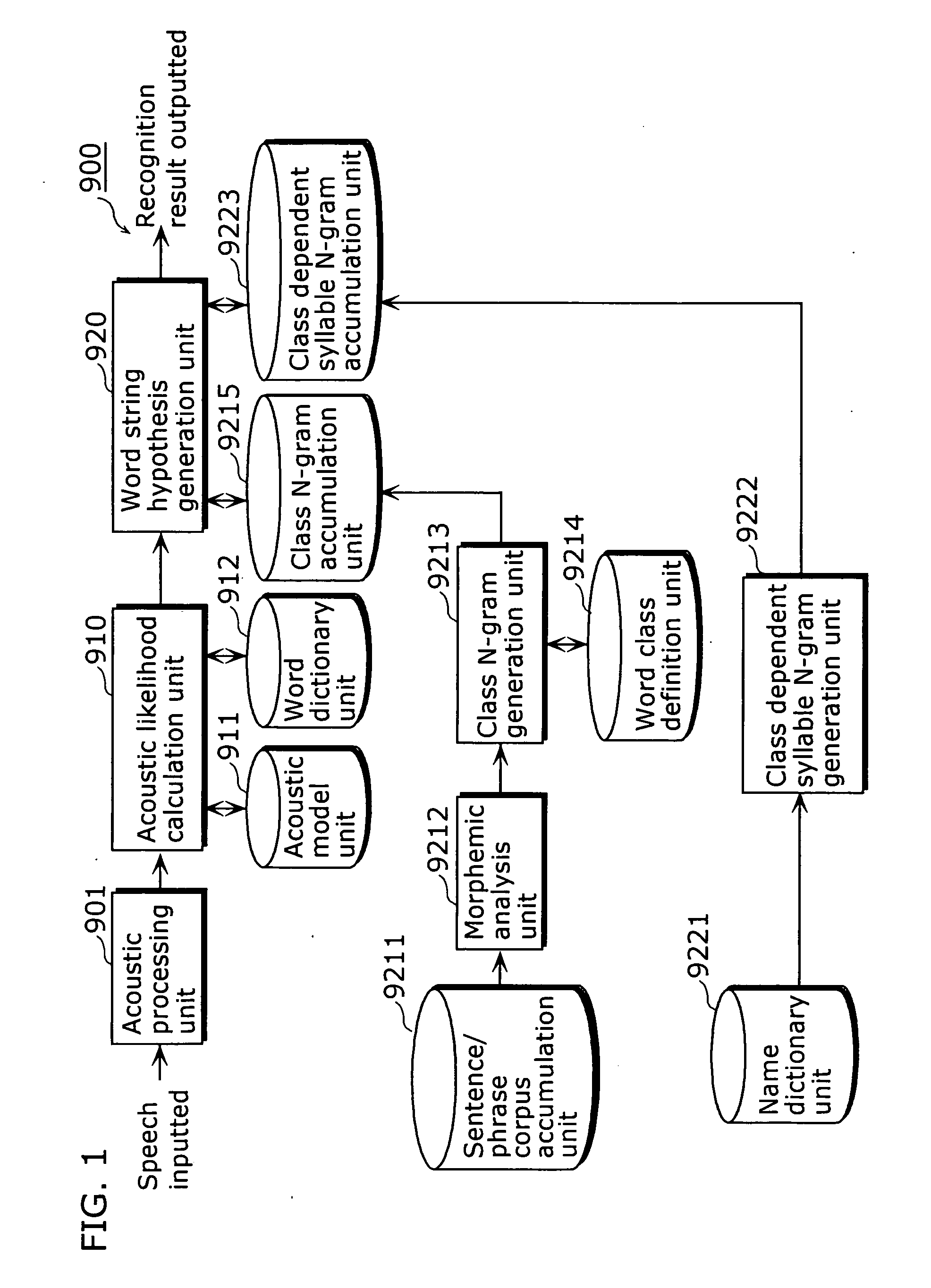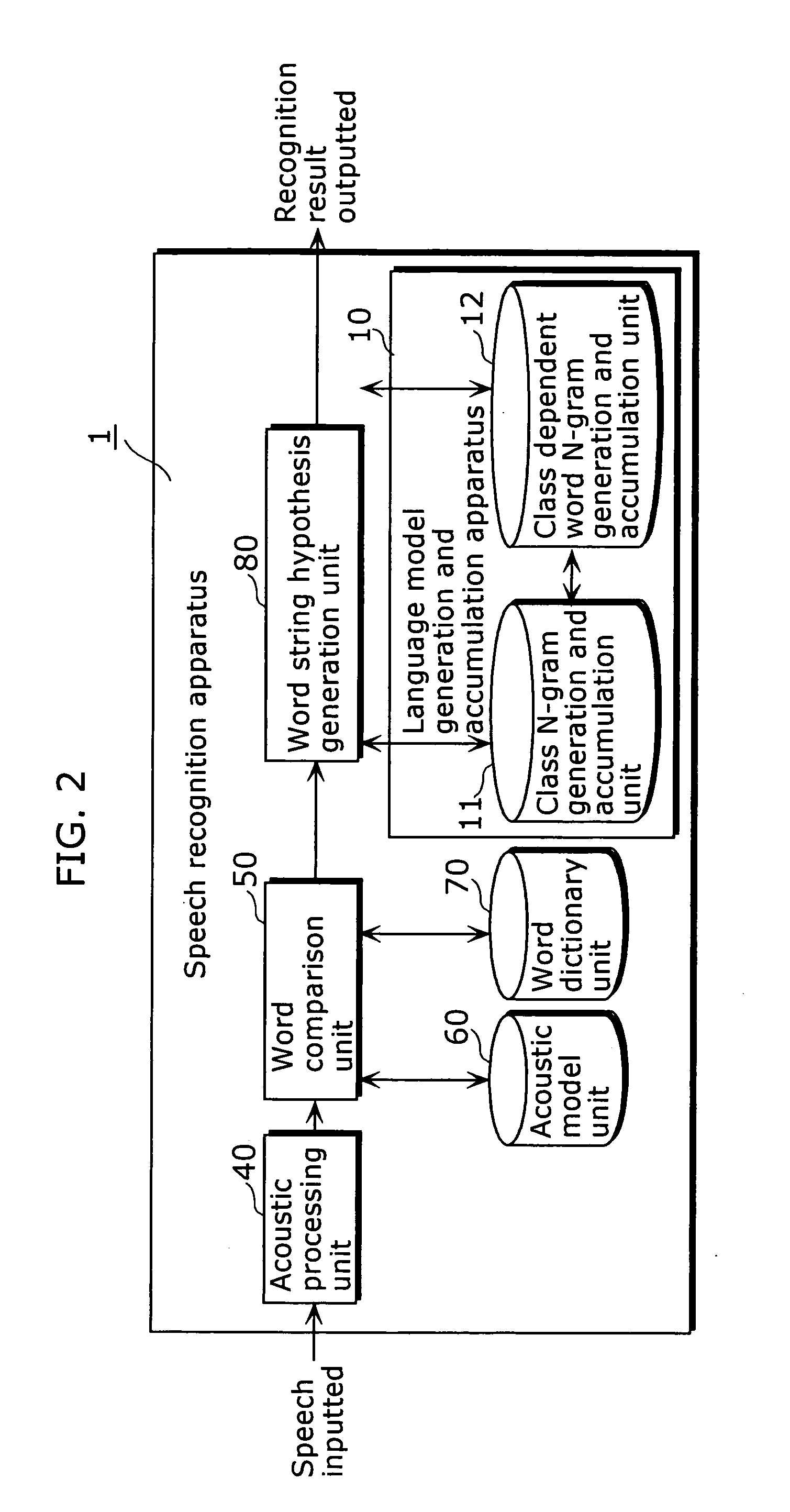Language model generation and accumulation device, speech recognition device, language model creation method, and speech recognition method
a language model and accumulation device technology, applied in the field of language model generation and accumulation devices, can solve the problems of low accuracy of language likelihood of word string with little training data, loose restrictions, and difficulty in improving the accuracy of linguistic prediction in the case of processing television program and cinema title, so as to achieve high recognition accuracy and valuable in terms of practicability.
- Summary
- Abstract
- Description
- Claims
- Application Information
AI Technical Summary
Benefits of technology
Problems solved by technology
Method used
Image
Examples
first embodiment
[0089]FIG. 2 is a functional block diagram showing the configuration of a speech recognition apparatus according to the first embodiment of the present invention.
[0090] As FIG. 2 shows, a speech recognition apparatus 1 is comprised of: a language model generation and accumulation apparatus 10; an acoustic processing unit 40 that captures an input utterance and extracts feature parameters; an acoustic model unit 60 that is a modeled acoustic feature of a specified or unspecified speaker; a word dictionary unit 70 that describes the pronunciations of words to be recognized; a word comparison unit 50 that compares the feature parameters against each word with reference to the acoustic model and the word dictionary; and a word string hypothesis generation unit 80 that generates word string hypotheses from each result of word comparison with reference to the class N-grams and the class dependent word N-grams of the language model generation and accumulation apparatus 10, and obtains a r...
second embodiment
[0144]FIG. 12 is a block diagram showing a functional configuration of a speech recognition apparatus according to the second embodiment of the present invention. Note that the same numbers are assigned to components that correspond to those of the language model generation and accumulation apparatus 10 and the speech recognition apparatus 1, and descriptions thereof are omitted.
[0145] As FIG. 12 shows, the speech recognition apparatus 2 is comprised of: a language model generation and accumulation apparatus 20 that is used instead of the language model generation and accumulation apparatus 10 of the above-described speech recognition apparatus 1; the acoustic processing unit 40; the word comparison unit 50; the acoustic model unit 60; the word dictionary unit 70; and the word string hypothesis generation unit 80.
[0146] The language model generation and accumulation apparatus 20, which is intended for generating class N-grams and class dependent word N-grams by analyzing the synta...
third embodiment
[0168]FIG. 17 is a block diagram showing a functional configuration of a speech recognition apparatus according to the third embodiment of the present invention. Note that recognition processing of the blocks that are assigned the same numbers as those in FIG. 2 is equivalent to the operation of the speech recognition apparatus 1 of the first embodiment, and therefore descriptions thereof are omitted.
[0169] As FIG. 17 shows, the speech recognition apparatus 3 is comprised of: a language model apparatus 30 and a recognition exception word judgment unit 90 that judges whether a word is a constituent word of a word string class or not, in addition to the acoustic processing unit 40, the word comparison unit 50, the acoustic model unit 60, the word dictionary unit 70, and the word string hypothesis generation unit 80.
[0170] The recognition exception word judgment unit 90 judges whether a calculation of language likelihood that is based on each occurrence probability in a word string c...
PUM
 Login to View More
Login to View More Abstract
Description
Claims
Application Information
 Login to View More
Login to View More - R&D
- Intellectual Property
- Life Sciences
- Materials
- Tech Scout
- Unparalleled Data Quality
- Higher Quality Content
- 60% Fewer Hallucinations
Browse by: Latest US Patents, China's latest patents, Technical Efficacy Thesaurus, Application Domain, Technology Topic, Popular Technical Reports.
© 2025 PatSnap. All rights reserved.Legal|Privacy policy|Modern Slavery Act Transparency Statement|Sitemap|About US| Contact US: help@patsnap.com



